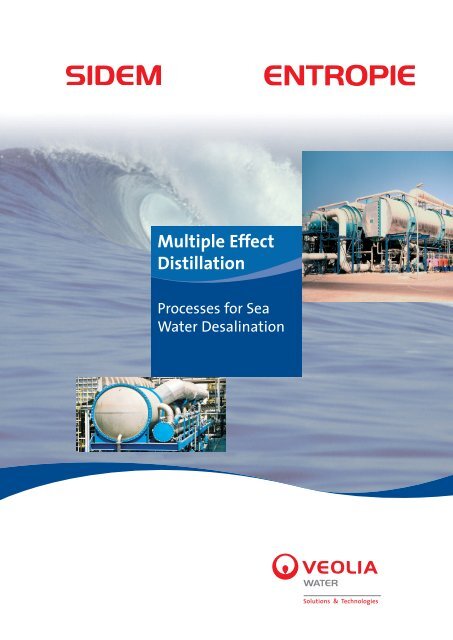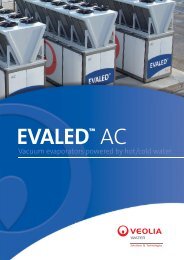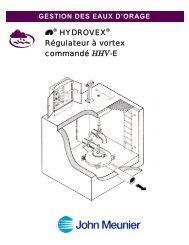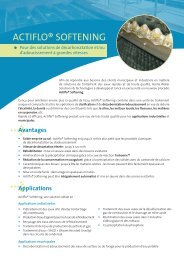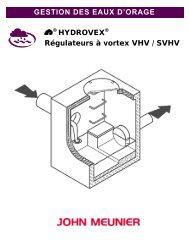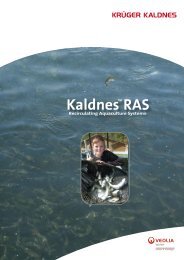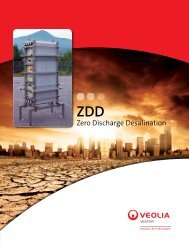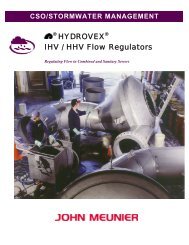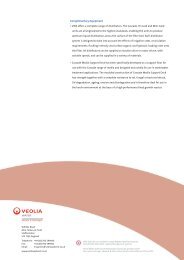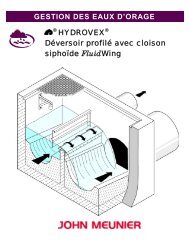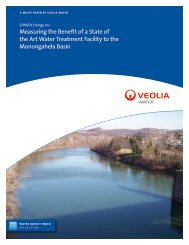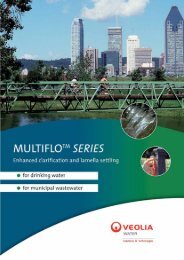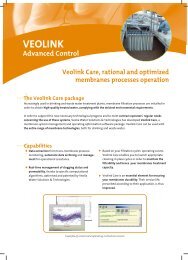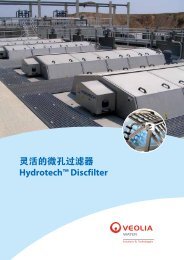Brochure Dessalement - Veolia Water Solutions & Technologies
Brochure Dessalement - Veolia Water Solutions & Technologies
Brochure Dessalement - Veolia Water Solutions & Technologies
You also want an ePaper? Increase the reach of your titles
YUMPU automatically turns print PDFs into web optimized ePapers that Google loves.
Multiple Effect<br />
Distillation<br />
Processes for Sea<br />
<strong>Water</strong> Desalination
The technology<br />
SIDEM / ENTROPIE is the world leader in sea water desalination through low temperature<br />
distillation processes such as:<br />
• Multiple Effect Distillation (MED)<br />
• Multiple Effect Distillation with Thermal Vapour Compression (MED-TVC)<br />
• Multiple Effect Distillation with Mechanical Vapour Compression (MED-MVC)<br />
BASICS ON THE MED PROCESS<br />
An MED evaporator consists of several consecutive cells (or effects) maintained<br />
at decreasing levels of pressure (and temperature) from the first (hot) cell to the<br />
last one (cold). Each cell mainly consists in a horizontal tubes bundle.The top of<br />
the bundle is sprayed with sea water make-up that flows down from tube to<br />
tube by gravity (see sketch 1).<br />
Heating steam is introduced inside the tubes. Since tubes are cooled externally<br />
by make-up flow, steam condenses into distillate (fresh water) inside the tubes.<br />
At the same time sea water warms up and partly evaporates by recovering the<br />
condensation heat (latent heat). Due to evaporation sea water slightly<br />
concentrates when flowing down the bundle and gives brine at the bottom of<br />
the cell. The vapour raised by sea water evaporation is at a lower temperature<br />
than heating steam. However it can still be used as heating media for the next<br />
effect where the process is repeated. The decreasing pressure from one cell to<br />
the next one allows brine and distillate to be drawn to the next cell where they<br />
will flash and release additional amounts of vapour at the lower pressure.<br />
This additional vapour will condense into distillate inside the next cell.<br />
Non-heated<br />
seawater<br />
Sketch 1<br />
STEAM<br />
Steam<br />
introduced<br />
60°C<br />
Brine<br />
50°C 40°C<br />
Produced<br />
Steam<br />
SEA WATER DISCHARGE<br />
Vent<br />
Condenser<br />
Distilled<br />
water<br />
This process is repeated in a series of effects (Multiple Effect Distillation)<br />
(see sketch 2 with 3 effects). In the last cell, the produced steam condenses on a<br />
conventional shell and tubes heat exchanger. This exchanger, called “distillate<br />
condenser” is cooled by sea-water. At the outlet of this condenser, part of the<br />
warmed sea-water is used as make-up of the unit, the other part is rejected to<br />
the sea. Brine and distillate are collected from cell to cell till the last one from<br />
where they are extracted by centrifugal pumps<br />
Condensate<br />
Sketch 2<br />
Thermocompressor<br />
BRINE<br />
DISTILLATE<br />
WATER<br />
Steam<br />
extracted vapour<br />
SEA WATER<br />
FEED<br />
The thermal efficiency of such evaporator can be quantified as the number of<br />
kilos of distillate produced per one kilo of steam introduced in the system. Such<br />
number is called the Gain Output Ratio (GOR).<br />
60°C<br />
50°C 40°C<br />
Vent<br />
Condenser<br />
SEA WATER<br />
DISCHARGE<br />
The GOR of the evaporator in sketch 2 can be enhanced by addition of a thermocompressor<br />
between one of the cells and the hot one.Using LP or MP steam this<br />
static compressor will take part of the vapour raised in one of the cells and<br />
recycle it into higher pressure vapour to be used as heating media for the first<br />
one. Sketch 3 shows the typical arrangement of an MED evaporator with<br />
thermocompression (MED-TVC).Whereas the GOR of the evaporator in sketch 2<br />
would be in the range of 3 (using LLP steam) the GOR of sketch 3 would rather<br />
reach 6 (using LP or MP steam).<br />
Condensate<br />
Sketch 3<br />
BRINE<br />
DISTILLATE<br />
WATER<br />
SEA WATER<br />
FEED<br />
COMPRESSOR<br />
When no steam is available, it is still possible to use the MED process with a<br />
Mechanical Vapour Compressor (MED-MVC). In such case the vapour is recycled<br />
from the cold cell to the hot one by means of a centrifugal compressor driven<br />
by an electrical engine (Sketch 4). The electrical consumption of such system is<br />
in the range of 8 to 15 kWh/m 3 . Due to current limitation in compressors<br />
technology the maximum capacity of MED-MVC units is 5000 m 3 /day.<br />
Preheater<br />
DISTILATE<br />
WATER<br />
BRINE<br />
SEA WATER<br />
Sketch 4<br />
2
Advantages of the MED processes<br />
MED & MED-TVC<br />
> Very low electrical consumption (1.5 kWh/m 3 ) compared to other thermal processes such as<br />
Multi Stage Flash (MSF) or membrane processes (Reverse Osmosis)<br />
> Operate at low temperature (< 70C°) and at low concentration ( Produce steadily high purity distillate<br />
> Do not need complex pre-treatment of sea water and tolerant to variations of sea water<br />
conditions<br />
> Are highly reliable and simple to operate<br />
> Reduce civil works cost thanks to reduced foot print<br />
> Are simple to install with the packaged unit mounted on skids and delivered ready for use,after<br />
simple installation<br />
> Have a low maintenance cost (No rotating parts except low pressure pumps)<br />
> Operate 24 hours a day with minimum supervision<br />
> Ideal for coupling with power plants, steam can be used at any pressure from 0.35 to 40 bar abs<br />
> Can be adapted to any heat source including hot water<br />
> Allow very high thermal efficiencies and savings in fuel costs<br />
> Range up to 15 MIGD (68 000m 3 /day)<br />
MED-MVC<br />
> Range up to 5000 m 3 /day<br />
> Are environmentally clean: 100% electrical process (no external heat source)<br />
> Have high energy efficiency: electrical energy consumption ranging from 8 to 15 kWh/m 3<br />
> Sea water consumption is reduced with only make up water necessary<br />
3
Characteristics of<br />
SIDEM-ENTROPIE MED design<br />
> <strong>Water</strong> spray through large opening nozzles or dismountable perforated plates:<br />
• Better water distribution - No risk of plugging<br />
• Allows final degasing of sea water<br />
> Low vapour velocities:<br />
• Low pressure losses<br />
• Better quality of distillate (< 2 ppm TDS)<br />
> Knitted stainless steel wire high efficiency demisters<br />
> Tubes expanded in tube plates: guarantee of a constant purity of distillate<br />
> Easy access to the evaporator internals<br />
> High quality selected materials<br />
> Factory assembled and tested (for capacities A complete range of standard MED-TVC and MVC units is available<br />
up to 3000 m 3 /day.<br />
ENERGY SOURCES FLEXIBILITY<br />
MED can be powered by almost any kind of heat source:<br />
> Very low Pressure (LLP) steam (0.35 to 1 bar a): MED<br />
> Low or medium Pressure (LP or MP) steam (over 2 bar a): MED-TVC<br />
> Hot water sources above 60°C: MED<br />
> Electricity: MED-MVC<br />
Steam or heat is available from:<br />
> Steam turbines<br />
> Gas turbine power plants (open and combined cycle)<br />
> Diesel generators<br />
> Heat recovery on flue gas cleaning and waste incinerators<br />
> Heat recovery on exothermal industrial processes<br />
> Geothermal waters<br />
4
SIDEM-ENTROPIE<br />
standard MED materials list<br />
EVAPORATOR CELLS<br />
Shell and tube plate:<br />
316 L or Duplex SS<br />
Tubes:<br />
Upper rows:<br />
Other rows:<br />
Titanium grade 2 SW 0.4 mm th.<br />
or 90/10 Copper Nickel 1 mm th.<br />
Aluminium Brass 0.7 mm th.<br />
or Cu-Ni 90/10 0.7 mm th.<br />
Vapour boxes:<br />
316 L or Duplex SS<br />
Demister: 316<br />
Spraying plates:<br />
Spray nozzles:<br />
316 L or Duplex SS<br />
Polypropylene<br />
SEA WATER, BRINE, DISTILLATE AND CONDENSATE PUMPS<br />
Impeller:<br />
Casing:<br />
ASTM A351 CD4 MCu<br />
(or CF3M for distillate and condensate)<br />
ASTM A351 CD4 Mcu<br />
(or CF3M for distillate and condensate)<br />
CONDENSER AND PREHEATERS<br />
Shell and tube plates:<br />
Tubes:<br />
<strong>Water</strong> boxes:<br />
316 L or Duplex SS<br />
Titanium grade 2 SW 0.4 mm th.<br />
or 90/10 Copper Nickel 1 mm th.<br />
316 L or Duplex SS<br />
VACUUM SYSTEM CONDENSERS<br />
Shell & tube plates:<br />
Tubes:<br />
<strong>Water</strong> boxes:<br />
316 L or Duplex SS or High Grade SS<br />
Titanium grade 2 SW 0.4 mm th.<br />
or 90/10 Copper Nickel 1 mm th.<br />
316 L or Duplex SS<br />
EJECTORS<br />
Thermocompressors:<br />
Vacuum ejectors:<br />
316 L or Duplex SS<br />
316 L or Duplex SS or High Grade SS<br />
Other materials can be proposed on case by case basis.<br />
5
Industrial references<br />
The high purity of produced water ( Cement Plants<br />
> Petrochemical Complexes<br />
> Oil Refineries<br />
> Mining Applications and<br />
Mineral Processing Plants<br />
> Methanol Plants<br />
> LNG Plants<br />
> Sugar Refineries<br />
> Power Plants<br />
> Chemical Plants<br />
MVC Process<br />
> Client: JV Kellogg, Technicas Reunidas & JGC<br />
> Site: Damietta (Egypt)<br />
> Number of cells: 1<br />
> End user: Segas Egypt LNG<br />
> Contract date: September 2002<br />
Capacity: 2 x 216 m 3 product water per day<br />
MED-TVC Process<br />
> Client: Technip & Snamprogetti<br />
> Site: Oman<br />
> Number of cells: 2<br />
> Top brine temperature: 70°C<br />
> End user: Omifco fertilizer complex<br />
> Contract date: September 2003<br />
Capacity: 3 x 2 400 m 3 /d<br />
Capacity: 1 440 m 3 /day<br />
MED-TVC Process<br />
> Client: Man Ferrostaal<br />
> Site: GL2Z Arzew (Algeria)<br />
> Number of cells: 2<br />
> End user: Sonatrach<br />
> Application: Petrochemical<br />
> Contract date: 2003<br />
6
I<br />
n the case where potable water is required, the pure product water can be blended with<br />
raw water in order to achieve adequate potable water at low price. If necessary a<br />
remineralisation plant can be included in the package.<br />
Capacity: 4 x 12 300 m 3 /d<br />
MED-TVC Process<br />
> Client: Technip<br />
> Site: Coke Calcining Plant in Bahrain<br />
> Number of cells: 4<br />
> GOR: 7.5<br />
> Application: distillate for boiler feed and<br />
potable water<br />
> End user: Aluminium of Bahrain<br />
> Year of contract: June 1999<br />
MED-TVC Process<br />
> Client: Hitachi<br />
> Site: Peru<br />
> Number of cells: 2<br />
> Top brine temperature: 70°C<br />
> Application: Power station<br />
> End user: Enersur<br />
> Contract date: December 1997<br />
Capacity: 2 x 1 300 m 3 /day<br />
Capacity: 2 x 2 500 m 3 /day<br />
MED-TVC Process<br />
> Client: YANBU CEMENT Co<br />
> Site: YANBU CEMENT Complex (Saudi Arabia)<br />
> Number of cells: 4<br />
> Top brine temperature: 66°C<br />
> Application: Cement factory<br />
> End user: Yanbu cement<br />
> Contract date: December 1994<br />
7
Municipal references<br />
The low electrical consumption, the high reliability and simplicity of operation together<br />
with its ability to be efficiently combined with power production make MED a first choice<br />
for large desalination plant producing drinking water for municipal applications.<br />
The following references are a few examples of MED successes over the past few years.<br />
Capacity: 4 x 9 000 m 3 /day<br />
MED-TVC Process<br />
> Client: TPL Italia<br />
> Site: Trapani (Sicily)<br />
> Number of cells: 12<br />
> End user: Sicilacque, for Sicily Region<br />
> Contract date: 1990<br />
> Particulars: the largest MED plant in the<br />
world when built in 1992. GOR 16,3.<br />
MED-TVC or MED Process<br />
> Client: AQUALECTRA<br />
(formerly KAE)<br />
> Site: Curacao Island<br />
Capacity: 12 000 m<br />
> Number of cells: 12<br />
3 /day<br />
> Contract date: 1994<br />
> Particulars: In winter the unit is driven by 2,45 bar abs LP steam at the thermocompressor<br />
nozzle (GOR 13,4). In summer it is fed by 0,35 bar abs LLP steam to cell 1 (GOR 9,8).<br />
8
Capacity: 3 x 13 330 m 3 /day<br />
MED-TVC Process<br />
> Client: General Electric Company of<br />
Libya (GECOL)<br />
> Site: Tobruk (Libya)<br />
> Number of cells: 6<br />
> Contract date: 1997<br />
> Particulars: The first large MED plant<br />
in Libya for municipal application.<br />
GOR 9,75.<br />
MED-TVC Process<br />
> Client: Abu Dhabi <strong>Water</strong> and Electricity<br />
Authority (ADWEA)<br />
> Site: Umm Al Nar Power Station (Abu Dhabi)<br />
> Number of cells: 6<br />
> Contract date: 1998<br />
> Particulars: Fed with 2,75 bar abs LP steam<br />
recovered from the power plant. A steam<br />
transformer is used to keep distillate free from<br />
any hydrazine contamination. GOR 7,9.<br />
Capacity: 2 x 16 500 m 3 /day<br />
Capacity: 2 x 22 700 m 3 /day<br />
MED-TVC Process<br />
> Client: Sharjah Electricity and <strong>Water</strong> Authority<br />
(SEWA)<br />
> Site: Layyah Power Station (Sharjah UAE)<br />
> Number of cells: 5<br />
> Contract date: 1999<br />
> Particulars: Combined with the power plant,<br />
these units are fed with MP steam at 16 bar<br />
abs through a steam transformer. GOR 8,4.<br />
9
Municipal references<br />
MED-TVC Process<br />
> Client: Total Tractebel EPC<br />
Company<br />
> Site: Taweelah Power and<br />
Desalination Plant (Abu Dhabi -<br />
UAE)<br />
> Number of cells par unit: 6<br />
Capacity: 14 x 17 143 m 3 /day<br />
> Contract date: 2000<br />
> Particulars: Fed with 2,75 bar abs LP steam recovered from the power plant through steam<br />
transformers (GOR 8). The largest MED plant in the world with 240 000m 3 /day.<br />
Capacity: 1 x 36 368 m 3 /day<br />
MED-TVC Process<br />
> Client: Sharjah Electricity and <strong>Water</strong><br />
Authority (SEWA)<br />
> Site: Layyah Power Station (Sharjah<br />
UAE)<br />
> Number of cells: 5<br />
> Contract date: January 2005<br />
> Particulars: Combined with the power<br />
plant this unit is fed with MP steam at<br />
16 bar abs through a steam transformer<br />
(GOR 8,4). The largest MED unit in the<br />
world with a compact design that allows<br />
this 8 MIGD MED-TVC unit to fit<br />
into the space allocation of a 5 MIGD<br />
MSF plant.<br />
10
The future of MED technology<br />
15 MIGD MED-TVC unit LP Steam @ 3 bar abs GOR 9.5<br />
R<br />
&D efforts towards<br />
the increase of MED<br />
units capacities have<br />
resulted in the key<br />
technologies being<br />
available for large plant<br />
such as 15 MIGD per<br />
single unit.<br />
The basic design beside<br />
shows the outlook of<br />
such plant:<br />
In addition MED-TVC allows unparalleled flexibility when combined with power plants thanks to<br />
the HYBRID MED concept. This concept provides two types of MED units:<br />
• The MED-TVC2 can be fed with two types of steam pressure depending on the load factor of the<br />
power plant. When electrical demand is high a lot of LP steam is available, when it is low the<br />
steam extracted from the turbines is a limited quantity of MP steam.<br />
• The MED-MTVC units can be driven by LP steam during high electrical demand, and with electrical<br />
power when electrical demand is low. Such unit provides a mechanical vapour compression<br />
system to be installed in parallel with the LP thermocompressor.<br />
An HYBRID MED system can use both types of units or one only, in all cases it brings very important<br />
savings on the production cost of fresh water.<br />
HYBRID MED in summer mode<br />
LP<br />
steam<br />
TVC 1<br />
TVC 2<br />
LP<br />
steam<br />
MVC<br />
TVC<br />
MED TVC 2<br />
Typical GOR 9<br />
MED MTVC<br />
Typical GOR 9<br />
TVC : Thermal<br />
Vapour Compressor<br />
MVC : Mechanical Vapour Compressor (Industrial Fans System)<br />
HYBRID MED in winter mode<br />
MP<br />
TVC 1<br />
kWh<br />
MVC<br />
steam<br />
TVC 2<br />
TVC<br />
MED TVC 2<br />
Typical GOR 10<br />
MED MTVC<br />
Typical consumption 14 kWh/m3<br />
11
SIDEM and ENTROPIE are part of VEOLIA WATER SOLUTIONS &<br />
TECHNOLOGIES, one of the world's leader in the design and<br />
construction of water treatment facilities for municipal and industrial<br />
applications, with more than 1.5 billion € turnover, and present in<br />
more than 50 countries with more than 6 000 employees.<br />
collaboration scheme<br />
SIDEM<br />
Large municipal plants<br />
ENTROPIE<br />
Industrial units<br />
CUSTOMERS WHO TRUST US<br />
E N T R O P I E S A S<br />
E N T R O P I E S A S<br />
SIDEM LIBYA<br />
P.O. BOX 6440<br />
Gargaresh km 7,5<br />
near Shuruk Super Market<br />
TRIPOLI – S.P.L.A.J.<br />
Tel: + 218 21 483 74 51<br />
Fax: + 218 21 483 47 90<br />
Abu Dhabi <strong>Water</strong> and<br />
Electricity Authority (UAE)<br />
Alstom (France)<br />
Aluminium of Bahrain<br />
(Bahrain)<br />
Aqualectra (Curacao)<br />
Aramco (KSA)<br />
Chiyoda (Japan)<br />
Electricité de France (France)<br />
Endesa (Spain)<br />
Enersur (Peru)<br />
Federal Electricity and <strong>Water</strong><br />
Authority (UAE)<br />
Fisia Babcock (Germany)<br />
Fluor Daniel (USA)<br />
Foster Wheeler (UK)<br />
Gecol (Libya)<br />
Groupe chimique tunisien<br />
(Tunisia)<br />
International Power (UK)<br />
JGC (Japan)<br />
Kellogg (UK)<br />
National Petrochemical<br />
Company (Iran)<br />
Man Ferrostaal (Germany)<br />
SIDEM ABU DHABI<br />
P.O. BOX 3609<br />
ABU DHABI<br />
Tel: +971 26 774 715<br />
Fax: +971 26 725 147<br />
Mitsubishi (Japan)<br />
OCP (Morrocco)<br />
QAFCO (Qatar)<br />
QP (Qatar)<br />
Rasgas (Qatar)<br />
Saipem (France)<br />
Saline <strong>Water</strong> Conversion<br />
Corporation (KSA)<br />
Sharjah Electricity and <strong>Water</strong><br />
Authority (UAE)<br />
Shell (Holland)<br />
Snamprogetti (Italy)<br />
Sonatrach (Algeria)<br />
Sonelgaz (Algeria)<br />
Suez Energy International<br />
Sumitomo Corporation (Japan)<br />
Technicas reunidas (Spain)<br />
Technip (France)<br />
Teda (China)<br />
Total (France)<br />
Union Fenosa (Spain)<br />
United Sugar (KSA)<br />
Yanbu Cement (KSA)<br />
ENTROPIE GMBH<br />
Haager Straße 2,<br />
D-85435 Erding,<br />
Deutschland<br />
Tel: +49 8122 9838 0<br />
Fax: +49 8122 9838 18<br />
03/2006 - All photographs, drawings and diagrams are property of ENTROPIE and SIDEM<br />
SIDEM<br />
20-22 rue de Clichy<br />
75009 Paris, France<br />
Tel: +33 (0)1 49 95 76 76<br />
Fax: +33 (0)1 49 95 76 95<br />
e-mail: sidem-paris@sidem-fr.com<br />
ENTROPIE SAS<br />
20-22 rue de Clichy<br />
75009 Paris, France<br />
Tel: +33 (0)1 56 35 35 00<br />
Fax: + 33 (0)1 56 35 35 01<br />
e-mail: info@entropie.com


